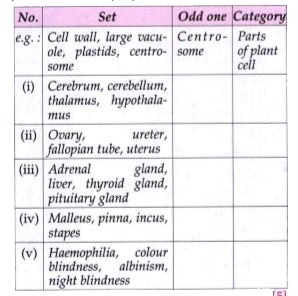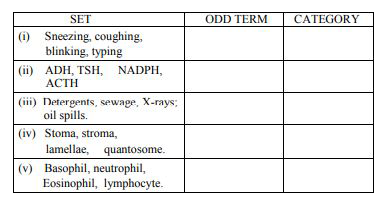Given below are six sets with four terms each. In each set one term is odd and cannot be grouped in the same category to which the other three belong. Identify the odd one in each set and name the category to which the remaining three belong. The first one has been done as an example.
Example: Calyx, Corolla, Stamens, Midrib
Odd term : Midrib
Category : Parts of a flower.
Transpiration, Photosynthesis, Phagocytosis, Guttation.
To solve the question, we need to analyze the given terms and identify the odd one out in each set, along with the category to which the remaining terms belong. Let's break down the solution step by step.
Step 1: Analyze the Terms
We have the terms: Transpiration, Photosynthesis, Phagocytosis, Guttation.
Step 2: Define Each Term
- Transpiration: The process of water vapor loss from the stomata of plants.
- Photosynthesis: The process by which green plants prepare their own food using carbon dioxide, water, and sunlight.
- Phagocytosis: The process by which a cell (typically an animal cell) engulfs large particles.
- Guttation: The process of water loss from the hydathodes of plants.
Step 3: Identify the Odd Term
From the definitions:
- Transpiration, Photosynthesis, and Guttation are processes that occur in plants.
- Phagocytosis is a process that occurs in animal cells.
Thus, the odd term is Phagocytosis.
Step 4: Name the Category for the Remaining Terms
The remaining terms (Transpiration, Photosynthesis, and Guttation) all belong to the category of Processes in Plants.
Final Answer
- Odd Term: Phagocytosis
- Category: Processes in Plants
---
We have the terms: Transpiration, Photosynthesis, Phagocytosis, Guttation.
- Transpiration: The process of water vapor loss from the stomata of plants.
- Photosynthesis: The process by which green plants prepare their own food using carbon dioxide, water, and sunlight.
- Phagocytosis: The process by which a cell (typically an animal cell) engulfs large particles.
- Guttation: The process of water loss from the hydathodes of plants.
From the definitions:
- Transpiration, Photosynthesis, and Guttation are processes that occur in plants.
- Phagocytosis is a process that occurs in animal cells.
The remaining terms (Transpiration, Photosynthesis, and Guttation) all belong to the category of Processes in Plants.
- Odd Term: Phagocytosis
- Category: Processes in Plants
Topper's Solved these Questions
- SAMPLE PAPER 2014BOOK - ICSECHAPTER - SAMPLE PAPER 2014EXERCISE - SECTION-I (CHOOSE THE CORRECT ANSWER)
5 Videos
- SAMPLE PAPER 2014BOOK - ICSECHAPTER - SAMPLE PAPER 2014EXERCISE - SECTION-II
72 Videos
- SAMPLE PAPER 2013BOOK - ICSECHAPTER - SAMPLE PAPER 2013EXERCISE - SECTION-II
56 Videos
- SAMPLE PAPER 2015BOOK - ICSECHAPTER - SAMPLE PAPER 2015EXERCISE - SECTION-II
63 Videos
Similar Questions
Given below are six sets with four terms each. In each set a term is an odd one and cannot be grouped in the same category to which the other three belong. Identify the odd one in each set and name the category to which the remaining three belong. The first has been done for you as an example.

View SolutionGiven below are six sets with four terms each. In each set one term is odd and cannot be grouped in the same category to which the other three belong. Identify the odd one in each set and name the category to which the remaining three belong. The first one has been done as an example.
Example: Calyx, Corolla, Stamens, Midrib
Odd term : Midrib
Category : Parts of a flower.
Oxytocin, Insulin, Prolactin, Progesterone.
View SolutionGiven below are six sets with four terms each. In each set one term is odd and cannot be grouped in the same category to which the other three belong. Identify the odd one in each set and name the category to which the remaining three belong. The first one has been done as an example.
Example: Calyx, Corolla, Stamens, Midrib
Odd term : Midrib
Category : Parts of a flower.
Haemoglobin, Glucagon, lodopsin, Rhodopsin.
View SolutionGiven below are six sets with four terms each. In each set a term is an odd one and cannot be grouped in the same category to which the other three belong. Identify the odd one in each set and name the category to which the remaining three belong. The first one has been done as an example:
Example : Fructose, Sucrose, Glucose, Calcium.
Odd term : Calcium
Category : Carbohydrates.
Sneezing, coughing, blinking, typing.
View SolutionGiven below is a set with four terms. In each set a term is an odd one and cannot be grouped in the same category to which the other three belong. Identify the odd one in each set and name the category to which the remaining three belong. The first one has been done as an example:
Example : Fructose, Sucrose, Glucose, Calcium.
Odd term : Calcium
Category : Carbohydrates.
Saliva, bile, sweat, tears.
View SolutionGiven below are six sets with four terms each. In each set a term is an odd one and cannot be grouped in the same category to which the other three belong. Identify the odd one in each set and name the category to which the remaining three belong. The first one has been done as an example:
Example : Fructose, Sucrose, Glucose, Calcium.
Odd term : Calcium
Category : Carbohydrates.
Cretinism, myxedema, simple goitre, acromegaly.
View SolutionGiven below are six sets with four terms each. In each set a term is an odd one and cannot be grouped in the same category to which the other three belong. Identify the odd one in each set and name the category to which the remaining three belong. The first one has been done as an example:
Example : Fructose, Sucrose, Glucose, Calcium.
Odd term : Calcium
Category : Carbohydrates.
Carbonic acid, acetic acid, benzoic acid, boric acid.
View SolutionIdentify the odd one in each set and name the category to which the remaining three belong :
Semicircular canals, Cochlea, Tympanum, Utriculus.
View SolutionIdentify the odd one in each set and name the category to which the remaining three belong :
Aqueous humour, Vitreous humour, Iris, Central canal
View SolutionGiven below are five sets with four terms each. In each set one term is odd. Choose the odd one out of the following terms given and name the category to which the others belong:

View Solution
